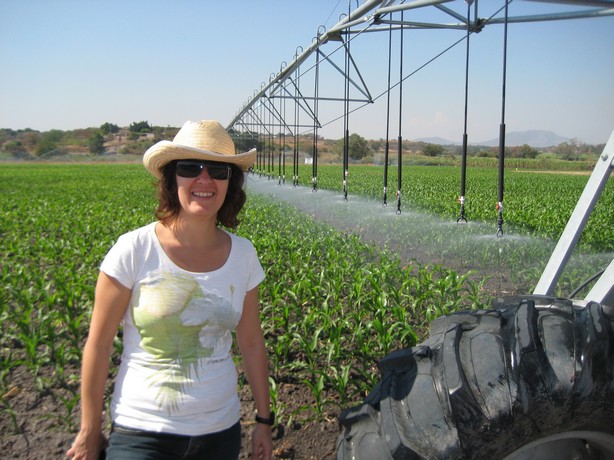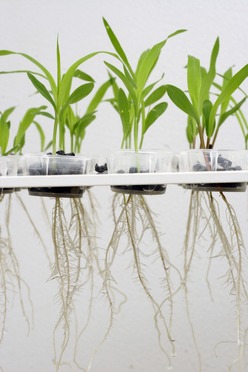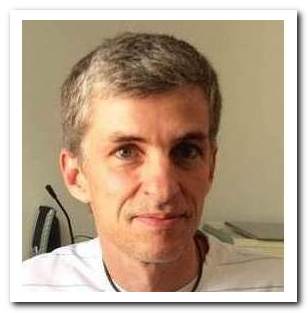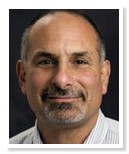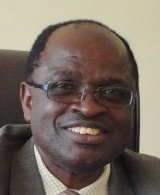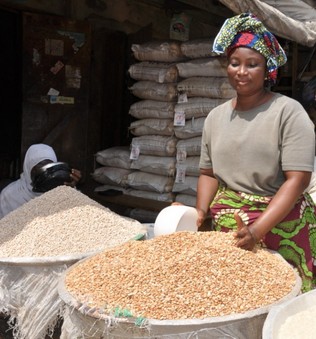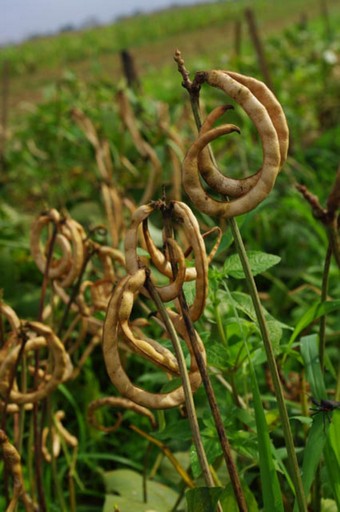 A shared vision
A shared vision
What is GCP all about and why is its work important? Why was GCP created? Read recollections from key people involved in GCP’s conceptualisation, and find out how realisation of the shared vision continues today. Featuring candid conversations with Masa Iwanaga, former Director General, CIMMYT; Dave Hoisington, Consortium Committee Chair; Andrew Bennett, Executive Board member; and Jean-Marcel Ribaut, GCP Director.
When was the last time you went to your local shop to buy something only to be told they’ve run out of it? How did you react? Like most of us, did you question how they could have run out – after all, isn’t it their business to adequately supply the demand?
Most likely you just went to another store. But what if there wasn’t another store around that had your product, or worse, there was actually a national shortage of your product? This is the reality that faces not just those after the latest iPad, but billions of people who just want something, anything, to eat.
With less productive land on which to grow crops, a more variable climate and more extreme weather events, farmers across all continents are struggling to produce crops, let alone increase yields to meet an ever-growing demand.
This scenario has continually raised its ugly head over the last 200 years as the world’s population has grown exponentially and shifted to urban surroundings. If not for the Green Revolution, inspired by the late Norman Borlaug’s agricultural development research within the Office of Special Studies in Mexico (now the International Maize and Wheat Improvement Center, more commonly known as CIMMYT, its Spanish acronym), the world population would have already suffered losses into the billions.
Even so, food insecurity is still recognised as a global challenge by the UN’s Food and Agriculture Organization (FAO). While there is debate over the cause for such insecurity, the advances of agricultural technology born from a Mexican-flavoured research programme are once again coming to the fore to meet the challenge.
Genebanks are not limited to conservation but are also a source of new alleles for crop improvement.
The genies in the genebank
Seedbank collections serve as insurance against unanticipated future threats to food security, the degradation of our environment and the loss of plant biodiversity.
But that is not all: the banks are not limited to conservation but are also a source of new alleles for crop improvement. The temperature-controlled CGIAR genebanks are a veritable treasure trove for plant breeding. Over the past four decades, their curators have scoured the planet, collecting, categorising and conserving more than 650,000 samples of crop, forage and agroforestry genetic resources, held in trust on behalf of humanity.
One such temperature-controlled genebank is located just outside the sweltering Mexico City: the CIMMYT genebank holds more than 150,000 unique samples of wheat and its relatives from more than 100 countries – said to be the largest collection of a single crop.
While genebank ‘stocks’ have always been open to plant breeders, it wasn’t until 2002 that CGIAR researchers embarked on a more structured and systematic approach using modern technologies to tap their breeding potential, thereby elevating the genebanks beyond their traditional collection and conservation role. Prior to that, far-sighted individual pioneering researchers had been studying (termed ‘screening’ in breeder-speak) the stocks for solutions to breeding problems and to improve crops, but the turning point for a concerted ‘institutional’ effort, would come in the early noughties.
By studying the genes of wild versions of, let’s say, wheat, researchers can find genes that could help cultivated wheat to better battle drought.
The dawn of a new generation
One of these researchers was Dave Hoisington (pictured), then with CIMMYT, and now Chair of GCP’s Consortiu m Committee, and ICRISAT’s Director of Research. Dave worked with the then newly appointed CIMMYT Director General, Masa Iwanaga, and helped draft a joint proposal with other institutes to CGIAR to form a Challenge Programme that could use the recent advances in molecular biology to harness their rich global stocks of crop genetic resources to create and provide a new generation of plants to meet farmers’ needs. This successfully gave rise to the CGIAR Generation Challenge Programme.
m Committee, and ICRISAT’s Director of Research. Dave worked with the then newly appointed CIMMYT Director General, Masa Iwanaga, and helped draft a joint proposal with other institutes to CGIAR to form a Challenge Programme that could use the recent advances in molecular biology to harness their rich global stocks of crop genetic resources to create and provide a new generation of plants to meet farmers’ needs. This successfully gave rise to the CGIAR Generation Challenge Programme.
“GCP’s first task was to go in and identify the genetic wealth held within the CGIAR banks,” says Dave.
“To do this, we wanted to use the most recent molecular tools, like molecular markers, to help scan the genomes and discover genes in species related to crops of interest that could help increase yield.”
Let’s use an analogy from a familiar medium – text: think of this story you are now reading as the plant’s genome, its words as its genes and a molecular marker as a text highlighter. You can use different markers to highlight different keywords in this story. Once you can see these keywords, you can then study them in more detail, and, in the case of genes, see what they control in the plant, and how they affect its different aspects.
 By studying the genes of wild versions of, let’s say, wheat, researchers can find genes that could help cultivated wheat to better battle drought.
By studying the genes of wild versions of, let’s say, wheat, researchers can find genes that could help cultivated wheat to better battle drought.
“At that time, we recognised that a Centre like CIMMYT could no longer undertake this tremendously complex task on its own,” recounts Masa (pictured).”We needed to work within a programme that could concentrate on the task and that rallied together various CGIAR Centres as well as research institutes outside CGIAR, especially in developing countries.”
Partnerships with spirit
Partnerships have always been a key ingredient to success. At the same time, they have led to the downfall of many projects.
Back in the early noughties, CGIAR recognised their business model and research system were not actively fostering partnerships between their different research Centres as much as they should have been, nor were they vigorously encouraging Centres to seek collaboration outside CGIAR.
 This was one of the fundamental reasons for establishing the Challenge Programmes, says Jean-Marcel Ribaut (pictured), who, in his role as GCP Director, has been credited by the Board and Committee for the significant time he has taken to broker, nurture and manage GCP’s partnerships.
This was one of the fundamental reasons for establishing the Challenge Programmes, says Jean-Marcel Ribaut (pictured), who, in his role as GCP Director, has been credited by the Board and Committee for the significant time he has taken to broker, nurture and manage GCP’s partnerships.
“One of our major outputs has been the human assets,” says Jean-Marcel with great pride. “We have created this amazing chain of people from the lab to the field.”
In fact, GCPs greatest asset – its ‘crown jewel’ – is its network of people and the capacity the Programme provides them with to buttress all the hard work, particularly in countries where the end products (crops) will be of most benefit.
…the GCP Spirit’ … is visible and palpable: you can recognise people working with us have a spirit that is typical of the Programme.”
“To make a difference in rural development, to truly contribute to improved food security through crop improvement and income for poor farmers, we knew we had to build capacity in these areas,” observes Jean-Marcel.
“I see our management style as fairly ‘paternal’, in the positive sense of wanting to see these groups of people succeed, and us helping them to do so. If a research site needs a pump for fieldwork, we work with a local or international consultant who will visit the partner and evaluate their needs, advise them on what type of pump they need, as well as other infrastructure they’ll need for the whole system to be sustainable. We’ll then provide training on how to use the pump most effectively. It’s an investment in the people as much as in the products they are working on because we are trying to change the system of how science within partnerships is conducted and supported, as much as we are trying tap genetic diversity and breed resilient crops for the developing world.”
We were attracted to GCP because of its strong facilitating role, which offered considerable support to addressing the bottlenecks associated with research programmes that researchers and CGIAR identified.”
This support and change have been major selling points for potential partners who have resonated with what Jean-Marcel calls ‘the GCP Spirit’ – partners open to sharing their skills, tools and knowledge, willing to sacrifice their views and leadership and, most importantly, support one another.
“It is visible and palpable: you can recognise people working with us have a spirit that is typical of the Programme,” says Jean-Marcel.
Funders like the Swiss Agency for Development and Cooperation (SDC) are attracted to, and impressed by, GCP’s approach as an honest and impartial ‘broker’.
 “We were attracted to GCP because of its strong facilitating role, which offered considerable support to addressing the bottlenecks associated with research programmes that researchers and CGIAR identified,” says Carmen Thönnissen (pictured), Senior Advisor at SDC.
“We were attracted to GCP because of its strong facilitating role, which offered considerable support to addressing the bottlenecks associated with research programmes that researchers and CGIAR identified,” says Carmen Thönnissen (pictured), Senior Advisor at SDC.
“GCP is also in line with SDC’s internal guidelines on Green Biotechnology, where it is our aim not to support single-donor initiatives but to work in larger programmes that have a clear focus on strengthening the national partner capacities too.”
At the beginning, most project leaders were from developed nations and CGIAR Centres. … now more than half of our projects are led by scientists in developing countries.”
A structured revolution within an evolution: aiming for products and sustainable change
GCP was designed in two phases over its 10-year life. The first was about the research and using genetic plant breeding techniques. The second and current phase focuses more on accessing modern breeding technologies and building capacity in developing countries to do the research for themselves.
Within nine years, GCP has produced useful tools and products from its studies of genetic resources.
These products have contributed to advancing knowledge, and will continue to do so into the future, particularly in plant breeding.
“At the very beginning, most project leaders were from established universities and institutes in developed nations, and CGIAR Centres. However, over time there has been a major shift and now we are proud that more than half of our projects are led by scientists in developing countries,” says Jean-Marcel. “They’ve moved from the position of implementers to the role of leaders, while the CGIAR Centres and institutes in developed countries have evolved more into mentors and teachers. We hope this empowerment will allow national programmes to grow and establish themselves to be sustainable when the funding dries up.”
Challenges within the Challenge Programme
All this talk about spirit, collaboration and partnerships does make it sound as if GCP has found the winning formula, but Jean-Marcel is quick to counter such notions, and there have been constant course corrections in charting the Programme’s path. “If anything, our strength comes from recognising our weaknesses, acknowledging that we don’t have it all worked out, and embracing change where it is needed.”
A mid-term external review was conducted in 2008 to audit the Programme’s weaknesses, strengths and lessons learnt from both. This review resulted in some governance reforming, bringing about the Consortium Committee and an independent Executive Board.
“It’s a major improvement that we have an independent Board, allowing for focus, and without any conflict of interest. I think they are doing a great job,” says Jean-Marcel. “They are monitoring and evaluating what we are doing, providing plenty of feedback and ideas on how to move forward, and contributing a lot to the success of the Programme.”
The Board’s focus now turns to auditing the Programme and mapping a strategy to sustain its successful partnerships and systems, so they can continue to deliver products and capacity to the developing world.
Bird’s eye view from the Board
 With more than 45 years of experience in international development and disaster management and, having worked in development programmes in Africa, Asia, Latin America, the Pacific and the Caribbean, Andrew Bennett (pictured) was a perfect candidate for the Board Chair.
With more than 45 years of experience in international development and disaster management and, having worked in development programmes in Africa, Asia, Latin America, the Pacific and the Caribbean, Andrew Bennett (pictured) was a perfect candidate for the Board Chair.
“We are committed to the role that can be played by science in development, and to the Programme,” says Andrew. “We have offered advice and helped the Programme’s Consortium Committee and management refocus the Programme. By all accounts, they seem happy with how things have evolved.”
Advice and helping aren’t normally the words associated with how a Board works but, like so much of the GCP family, this isn’t a classical board.
Andrew explains “Because GCP is hosted by CIMMYT, the Board does not have to deal with any policy issues. That is the responsibility of the Consortium Committee. Our role is more to provide advice and to help with decision-making and implementation, which is great as we’ve been able to focus on the Programme’s science and people.”
That focus now turns to auditing the Programme and mapping a strategy to sustain its successful partnerships and systems, so they can continue to deliver products and capacity to the developing world.
Turning sunset to sunrise
With only two-and-a-half years left to run, Jean-Marcel and his team are working just as passionately on sustaining the partnerships, projects and outputs that GCP has created.
“We knew we weren’t going to be around forever, so we had a plan from early on to hand over the managerial reins to other institutes, including CGIAR,” says Jean-Marcel, with the slight affliction of a parent helping their child move out of home.
“We have begun integrating projects into the CGIAR Research Programmes (CRPs) which we hope will allow them to continue to grow and work effectively towards the goals set.”
At the same time, the Management Team, Committee and Board are all busy auditing the successes and failures of the Programme to quantify the achievements of what has been termed as one of the CGIAR’s more successful Challenge Programmes, and on how to make GCP products freely accessible to other research institutes and programmes.
Relevant links
Links to external websites
